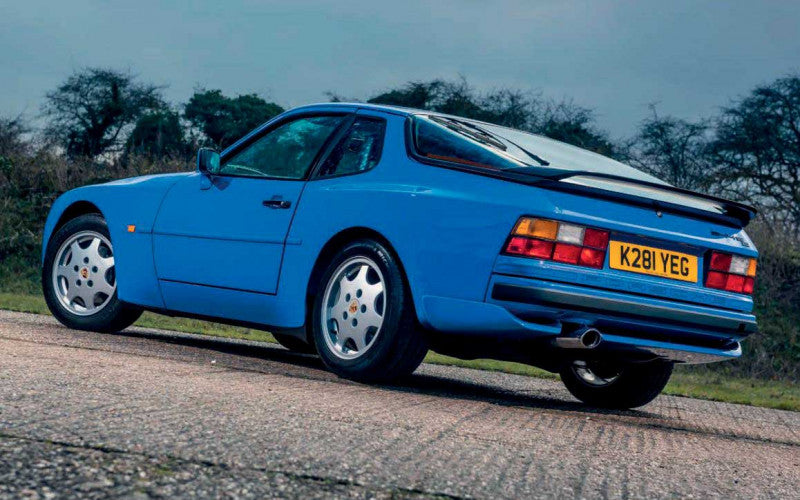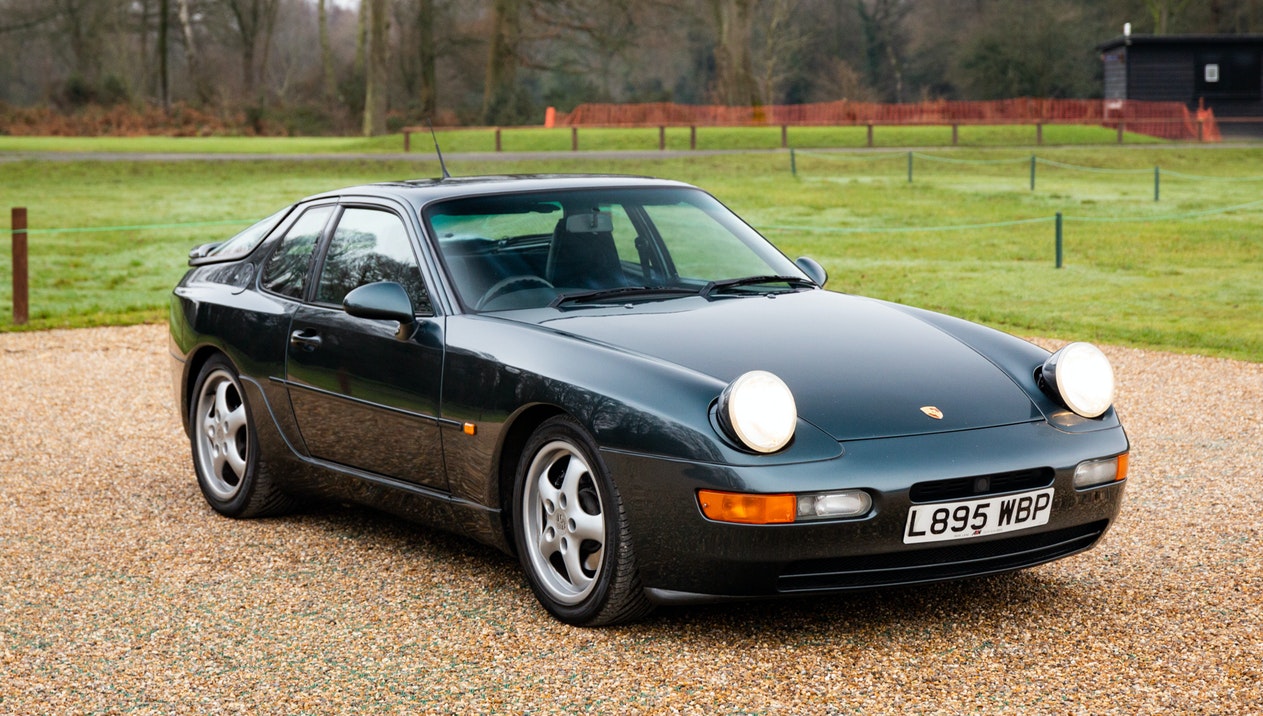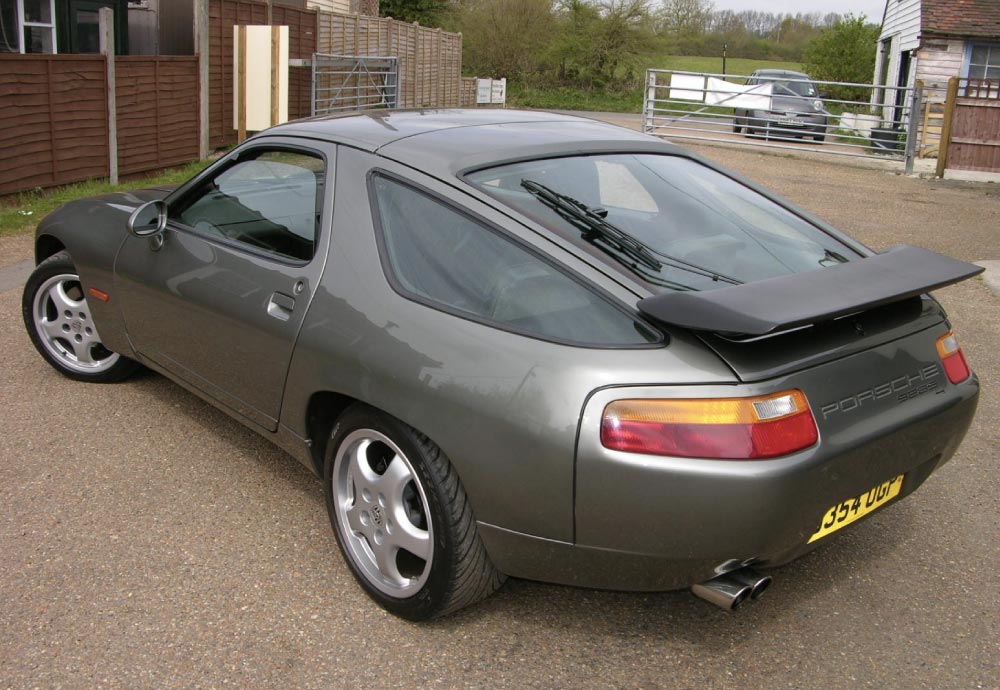The Porsche 944 was introduced in 1982 to replace the Porsche 924 as their entry level model, although the 924 continued until 1988 as an even lower-priced alternative. Production ended in 1991 when it was replaced by the Porsche 968. The 944 was a huge success for Porsche throughout the 1980s, and was available in several forms throughout its evolution: 944, 944S, 944 Turbo, 944S2, and the 944 Turbo S.
History and model overview
The 944 was introduced in 1982 with a 2.5 L straight-4 engine whose design was based on one half of the Porsche 928's V8 engine. While the design was very similar to the V8, very few parts were interchangeable. The 944 was based on the earlier 924 model, but featured numerous changes including updated bodywork with flared wings and a rear spoiler similar to that on the previous 924 Turbo. The interior was mostly the same as the 924, except for new climate control switches.
In mid-1985 the 944 underwent its first significant changes. The interior's ergonomics and air conditioning system were improved with a completely new dash and door panels, and the radio antenna was moved from a standard vertical position to being embedded in the windshield. The alternator was upgraded from a 90 amp alternator to a 115 amp alternator. Other changes included a change in oil sump capacity, new front and rear cast aluminum control arms and semi-trailing arms, a larger fuel tank, optional heated and powered seats, a Porsche HiFi sound system, revised starter, and revisions in the mounting of the transaxle to reduce noise and vibration. The "cookie cutter" style wheels used in the early 944s were upgraded to new "phone dial or tele-dial" style wheels.
In 1985 Porsche introduced the 944 Turbo, a higher-performance variant, known internally as the 951 (952 for right-hand drive models). This had a turbocharged and intercooled version of the standard car's engine that produced 220 hp (217 in the US) at 6000 rpm. The turbo was the world's first car using a ceramic portliner to lower temperatures inside the engine. The Turbo also featured several other revisions, such as improved aerodynamics, a strengthened gearbox, wider wheels, and uprated suspension. Major engine component revisions, more than thirty in all, were made to the 951 to compensate for increased internal loads and heat.
In 1987, the naturally-aspirated 944S ("Sport") variant was introduced. The 944S had a more powerful engine (190 bhp), which marked the first use of four valve per cylinder heads in the 944 series. Also in 1987, dual air-bags and an anti-lock brake system were introduced as options on the base model. Wheel offset was increased from 23 mm to 52 mm to provide clearance for the optional ABS brakes.
In 1988 Porsche introduced the 944 Turbo S. The 944 Turbo S had a more powerful engine with 247 hp (compared to the standard 944 Turbo's 220 or 217 hp) and 250 ft·lbf torque (versus 243 ft·lbf). This higher output was achieved by using a larger turbo housing on the exhaust side, a remapped engine computer , and larger sodium-cooled exhaust valves. In June of 1988, Car and Driver tested the 944 Turbo S and achieved a 0-60 mph time of 5.5 seconds and a quarter mile time of 13.9 seconds at 101 mph. This made the 944 Turbo S the fastest production four cylinder car of its time.
The 944 Turbo S's suspension was significantly upgraded with Koni adjustable shocks front and rear, ride height adjustment threaded collars on the front struts, progressive springs, larger rear torsion bars, harder bushings throughout, and larger sway bars front and rear. The 944 Turbo S wheels, known as the Club Sport design, were 16" forged and flat-dished, similar to the contemporary 928. Wheel widths were 7 inches in the front, and 8 inches in the rear; sizes of the Z-rated tires were 225/50 in the front and 245/45 in the rear. The transmission of the 944 Turbo S had hardened first and second gears, an external cooler to deal with the extra power, and a standard limited slip differential. The Turbo S front brakes were borrowed from the Porsche 928 S4, with larger calipers and rotors; ABS was also standard.
In 1989 the 'S' designation was dropped from the 944 Turbo S, and all 944 Turbos featured the 'S' package as standard. The regular 944's displacement was increased to 2.7 L. 1989 also saw the introduction of the 944S2, which had a 208 hp 3.0 L engine, the largest four-cylinder gasoline engine in the world at the time. The 944S2 had the same rounded nose and a rear valance found on the Turbo model. The S2 was also available as a cabriolet, a first for the 944 line.
In 1990 the 2.7 L base model was discontinued.
In February 1991 Porsche released the 944 Turbo Cabriolet, which combined the Turbo S's 250 hp engine with the cabriolet body. Porsche initially announced that 500 would be made; ultimately 625 were built, 100 of which were right-hand drive for the United Kingdom market. None were imported to the US.
In early 1990, Porsche engineers began working on what they had intended to be the third evolution of the 944, the S3. Once invested into the development process, they realized that so many parts were being changed that they had produced an almost entirely new vehicle. Porsche consequently shifted development from the 944 S3 to the car that would replace the 944 entirely, the 968. The 944's final year of production was 1991; in 1992 the 968 debuted. The 968 was sold alongside the 928 through 1995, when both models were discontinued.
Production
944
A total of 113,070 944s were made between 1982 and 1989, with 56,921 being exported to the United States.
944 Turbo (951)
A total of 25,107 944 Turbos were made, with 14,235 being exported to the United States.
944S
A total of 12,936 944S's were made in 1987 and 1988, with 8,688 being exported to the United States.
944S2
A total of at least 6,439 944S2s were made between 1989-1991, with 1,929 being exported to the United States. An additional 5640 944S2 cabriolets were produced in these years, with 2,402 being exported to the United States.
Did you enjoy this article? Avoid missing future publications by subscribing to this blog's RSS feed using
https://frazerpart.com/blogs/porsche-history.atom






